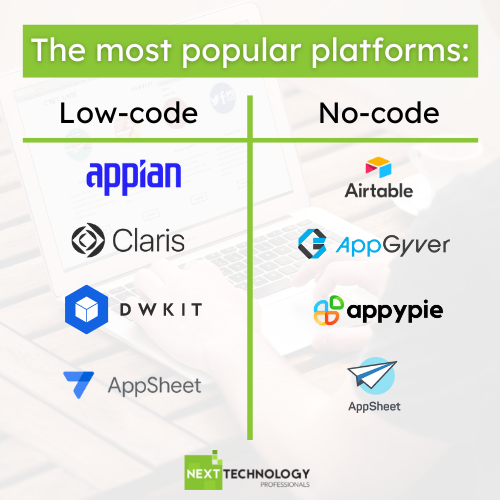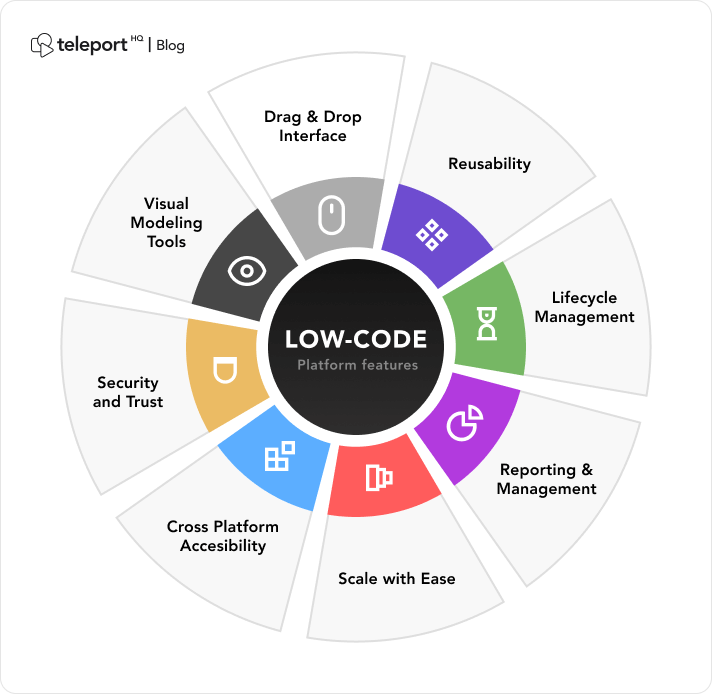Best Reasons On Picking Low-Code Platform Info
Best Reasons On Picking Low-Code Platform Info
Blog Article
Advantages Of Low-Code Application Development With Regard To Accessibility For Non-Developers
The following main factors make low-code development accessible to non-developers.
Drag-and-Drop Builders: Low-code platforms have drag-and drop interfaces that let non-developers create applications without having to write code. This makes it easier for people who don't have technical backgrounds to get involved in the development process.
WYSIWYG editors Editors that use WYSIWYG: These "What You See Is What You Get" editors allow users to build interfaces and workflows that are like the final product. This makes it much easier to understand and use.
Simplified logic and Workflow Design
Visual Workflow Modelling: Users are able to create business procedures, application logic, and flowcharts through diagrams as well as visual flowcharts. These methods are much more intuitive than traditional coding methods.
Low-code platforms typically come with pre-built logic elements (e.g. the conditional statements, loops) that eliminate the requirement for complex coding.
Templates and components that can be reused:
Library of Templates pre-built: A lot of platforms that allow low-code come with a library of template types for the most common applications. This allows developers to begin their journey quickly and effortlessly while non-developers are able to customize the templates as they see fit.
Reusable widgets and modules: The development of web pages is made simpler by using reusable components as well as modules. This eliminates the requirement for technical expertise.
Tutorials and Guided Development
Step-by-Step guides: Platforms provide tutorials and online assistance to non-developers who are building applications.
Interactive Tutorials. Interactive, hands on tutorials let users gain knowledge by doing.
Integration with tools already in use
Seamless integration Low-code platforms are designed to easily integrate with existing tools and systems for business (e.g. ERP, CRM) allowing non-developers create applications within their current workflows.
APIs Connectors: APIs integrate into apps to facilitate integration. This allows non-programmers, who do not have coding skills, to connect to external services.
Collaboration Features:
Team Collaboration: real-time collaboration, shared workspaces and shared workspaces permit non-developers, business analysts and other users to efficiently work with professional developers.
Access Control based on Role: Users who are not developers can be assigned specific roles and access levels. This allows them to participate in the development process without compromising security and functionality.
Automated Testing and Debugging
Low-code platforms come with tools to test and debug that are built-in. They automatize the process, making it simpler for non-developers to ensure their apps run.
Error Highlighting: If problems occur the platform flags errors and suggests fixes by guiding non-developers through troubleshooting procedures.
The main benefit of low-code development for accessibility to non-developers is its capacity to democratize the development process. With its intuitive, visually-focused tools and guided experiences low-code applications allow users of business to be actively involved in the creation and maintaining applications, which bridges the gap between requirements of business and the technical implementation. Have a look at the best use this link on Low-code Platform for application development for website recommendations including rad application development, application modernization, software for app development, cross platform app development, application modernisation, push alerts, sso azure, software for app development, low code platforms, push alerts and more.
The Low-Cost Of Development Is Among The Major Benefits.
Low-code development offers a number of advantages when it comes to cost-effectiveness. Companies seeking to reduce costs are able to benefit from this option while delivering quality applications. Here are the top benefits: Reduced development costs:
A Less Code Required Low-code platforms reduce the need for a lot of hand-coding, which reduces the amount of time and effort developers must to put into developing applications. The result is lower labour costs.
Less developers: Since low-code development is quicker and more simple to develop, there are less specialized developer resources required. This could significantly cut down on the cost of hiring and staffing.
Speedier Time to Market
Accelerated Development: Low-code platforms provide visual development tools, pre-built components and other tools that allow rapid development of applications. Businesses can bring their products to market more quickly. This can result faster revenues, as well as improved positioning in the market.
Rapid prototyping allows businesses to develop and test prototypes in a short time, which reduces the time required for the development phase. This allows them to make faster iterations after receiving user feedback.
Lower cost of maintenance:
Because of their modular design and standardised components, low-code platforms typically simplify the maintenance of applications. This reduces the cost of ongoing maintenance.
Automated updates: Many low-code platforms automatically manage patches and updates, ensuring that applications are secure and current with no need for manual intervention.
Efficient Resource Utilization:
Contributions by non-developers: Low-code platforms allow non-developers, such as business users, to participate in the process of development. This decentralization of development processes permits companies to tap into the expertise and talents of a wider range of employees.
Optimized Use of IT Resources: IT departments can focus on more strategic initiatives instead of being slammed with routine development tasks which can increase overall efficiency and productivity.
The Scalable Pricing model
Subscription-Based Pricing: A lot of low-code platforms provide flexible, subscription-based pricing models that scale with the amount of usage. This allows businesses to align their spending with the actual requirements and expansion, while avoiding huge initial cost.
Pay-Asss-You-Go Option: Some platforms have pay-ass-you go options that guarantee companies only pay when they utilize resources. This is particularly helpful for startups and smaller businesses with a limited budget.
Reduction in Third-Party Software Costs:
Low-code platforms typically come with integrated functions that eliminate the need to purchase additional software or tools. This can save you cash on subscriptions and licensing costs.
Pre-Built Integrations: The possibility of having pre-built intiations with well-known systems and services reduces the need for the need for custom-designed development. This saves time as well as cash.
Improved ROI
Faster return on Investment (ROI) by combining rapid application development with less expense and a quicker time to market, companies are able to achieve a faster ROI for their applications.
Improved agility: Companies can adapt quickly to changes on the market or to customer demands, which allows businesses to stay relevant and make the most of new opportunities.
Low-cost Training:
User-friendly interfaces: Low-code systems have intuitive and user friendly interfaces that help reduce the learning curve. They also eliminate the need for lengthy courses of instruction.
Accessible Resources: Many low code platforms come with complete tutorials and training materials and also community assistance. These resources eliminate the requirement for formal education and its associated expenses.
Collaboration is streamlined:
Collaboration Tools: Collaboration tools integrated enhance communication and coordination between teams, leading to better processes for development, and less overhead.
Unified Development Environment (UDE): An unified, single development environment simplifies workflows and reduces the costs and complexity of managing multiple platforms and tools.
In general, low-code apps are cost-effective due to their ability to reduce the cost of development and maintenance and to speed up time-to-market to optimize the use of resources, and to provide an affordable pricing. These factors combine to deliver huge financial benefits to companies and make low-code development a viable option for companies looking to maximize their development budgets while achieving high-quality, flexible high-quality and robust applications. Read the most popular a fantastic read on Enterprise application development with Low-code Platform for site advice including build with docker, cloud software applications, software for app development, mobile development platforms, app dev platform, push notifications android, microsoft azure sql, driver jdbc, develop cross platform mobile app, build a docker container and more.
Benefits Of Low-Code Application Development In Terms Of Community Support And Vendor Support
Low-code platforms for application development have major advantages in terms the support provided by vendors and communities. These are essential for the success of implementation, continuous maintenance and constant enhancement of applications. Here are a few principal benefits: Support from the vendor
Comprehensive Technical Support:
Support Teams: Several Low-Code platforms provide access an experienced support team that can help with technical issues, guidance and troubleshooting.
Some vendors offer 24/7 support. This can be very beneficial for businesses who operate in different time zones.
Onboarding and Training:
Structured Training: A number of vendors offer structured training, like tutorials, webinars and certification classes to aid users in becoming familiar with their platform.
Personalized onboarding: Many vendors have tailored services for new customers, to help them implement the platform correctly and tailor it to suit their specific needs.
Regular updates and improvements:
Continuous Improvement: Low code platform vendors regularly release updates that include new features, security patches and improvements to performance. This helps ensure that the platform remains up-to-date and secure.
Feedback integration: Vendors often incorporate user feedback into their process of development to ensure that the platform is able to meet the changing demands of their users.
Comprehensive Documentation:
Documentation is detailed users are able to access a large and well-organized documents that range in complexity from simple customization to advanced usage.
API References API documentation provides detailed API references that can help developers integrate their low-code platform applications with other platforms.
Professional and Consulting Services
Expert Consulting : Vendors offer consultancy services, including designing architecture and complex implementations. They provide this service in order to make sure that their users are able to benefit from the platform.
Custom Development Services: A few providers offer custom development services that allow you to create specific integrations or features that are not included in the default.
Community Support
Active User Communities:
Discussion and Forums: Many Low-code platforms feature vibrant online communities which allow users to ask questions, discuss strategies, and even collaborate with each other on best practices.
User Groups and Meetups: Virtual and local user groups and meetups provide opportunities for networking, learning and sharing experiences with fellow users.
Knowledge Sharing and Collaboration:
Community-Contributed Resources: Users often share templates, modules, and extensions that they have developed, which can be reused or adapted by others, accelerating development and innovation.
Crowdsourced problem solving The collective experience and expertise of the crowd is a valuable resource when troubleshooting problems and coming up with inventive solutions.
Learning and Development:
Community-Led training: Many communities offer webinars, workshops, and training sessions that are led by experts in the field.
Online Tutorials and Courses Community members frequently create and distribute online courses, tutorials and how-to guides, making better education resources available to all users.
Feedback and Influence
Community Forums for Product Feedback offer a variety of channels for providing feedback to vendors, which can influence the design of new features.
Beta Testing Programs: Members of active communities might be able to take part in beta testing programs, which gives them early access to new features and a voice in influencing the evolution of the platform.
Recognition and Assistance:
A lot of vendors offer community recognition programs for community recognition. These programs honor active members of the community and also include MVP programs.
Peer Support: Community members often provide peer support offering their expertise and providing guidance for users who aren't as experienced creating a more collaborative and supportive environment.
Overall, the combination of robust support from the vendor and an active connected community offers an extensive support system for the development of low-code applications. Users will have the ability to get the help, resources and collaboration opportunities they need to develop and deploy, manage and further enhance their apps.